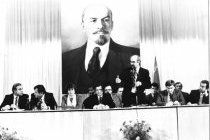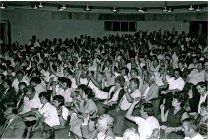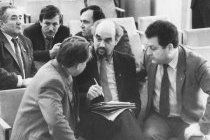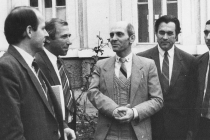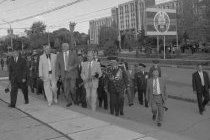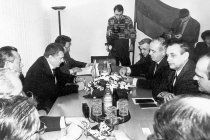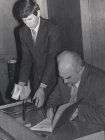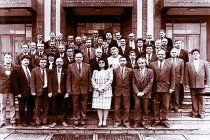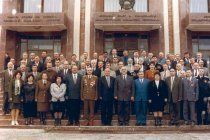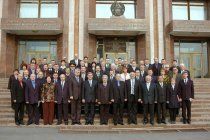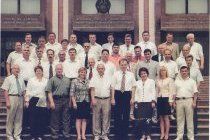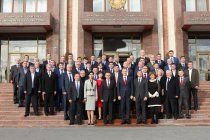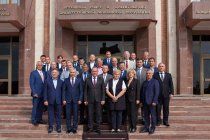 Русский
Русский English
English-







The PMR Supreme Council is 33
33 facts from the history of the main representative and only legislative body of power of our country in honor of the 33rd anniversary of the Supreme Council of the Pridnestrovian Moldavian Republic.
1. The Provisional Supreme Council operated in Pridnestroviу from September 2 to November 25, 1990. The decision to create it was made at the Second Extraordinary Congress of People's Deputies of all levels on September 2, 1990. Igor Smirnov was elected Chairman of the PMSSR Air Force;
2. The Provisional Supreme Council was a structure that performed the mixed functions of the legislative and executive branches of Government;
3. The Provisional Supreme Council adopted more than 60 laws and resolutions: on the creation of the Republican Bank, the formation of the state budget, the organization of urgent measures to provide assistance to citizens, the material and technical supply of enterprises, as well as on the formation of the Tiraspol State University (since January 1991 - the Tiraspol State University - corporate university of the Pridnestrovian region). The leadership of the republic decided to merge Tiraspol State Corporate University and the Pridnestrovian State Pedagogical Institute named after T.G. Shevchenko in 1992. This is how the Pridnestrovian State-Corporate University named after T.G. Shevchenko (since 1997 – Pridnestrovian State University named after T.G. Shevchenko);
4. Elections to the Supreme Council of the TMSSR took place on November 22-25, 1990. 81% of voters took part in them;
5. The first meeting of the Supreme Council of the TMSSR of the 1st convocation took place on November 29, 1990;
6. The right to open the meeting was given to one of the oldest deputies Vasily Yakovlev, an authoritative legal scholar, one of the future authors of the Declaration of Independence of the PMR and the first Pridnestrovian Constitution;
7. Pridnestrovian deputies honored the memory of those who fell during the tragic events in Dubossary on November 2, 1990 with a minute of silence at the first meeting of the Supreme Council of the PMSSR;
8. Igor Smirnov was elected the first Chairman of the Supreme Council. After his election as Chairman of the TMSSR, the position of speaker was taken by Grigory Marakutsa;
9. The first convocation of Parliament was bicameral and consisted of the Council of the Republic and the Council of Nationalities;
10. The Council of Nationalities included 8 people each: Russians, Ukrainians, and Moldovans. Representatives of other nationalities were also included in the same chamber. Total – 28 people. Alexander Karaman was elected Chairman;
11. The Council of Nationalities had the right to veto any law-in-draft that could, to one degree or another, infringe on the interests of representatives of any nationality living in Pridnestrovie;
12. The Council of the Republic included 35 deputies. Vladimir Gonchar was elected chairman. The main task of the Council of the Republic was the development of legislations;
13. The Supreme Council was initially guided by laws that had been in force since Soviet times. These laws were gradually redrawn to reflect Pridnestrovian reality;
14. The second session of the Supreme Council of the TMSSR adopted the Decree on State Power in a new edition and the Declaration of Sovereignty on December 8, 1990. These documents set out the basic principles of the exercise of state power and management. They formed the basis of the future Constitution of the Pridnestrovian Moldavian Republic;
15. The Supreme Council of the first convocation met once a month. If necessary, then more often;
16. The first meetings of the Supreme Council of the TMSSR were held in the House of Soviets (now the building of the state administration and city council of Tiraspol);
17. The current building of the Supreme Council and the Government of the Pridnestrovian Moldavian Republic in the early 90s was occupied by the Tiraspol City Committee of the Communist Party of the MSSR. A branch of the state university was located here after the collapse of the Soviet Union and since 1991 the Pridnestrovian parliament has been sitting there;
18. The building of the Supreme Council and the Government of the Pridnestrovian Moldavian Republic was erected in 1983. A monument to Vladimir Lenin was erected in 1987 on a high pedestal in front of the building on the occasion of the 70th anniversary of the October Revolution. The prototype was the famous 19-meter monument to the leader of the world proletariat in Berlin;
19. The monument to Vladimir Lenin in Berlin was created by the famous Soviet sculptor Nikolai Tomsky. The monument to Lenin in front of the Supreme Council of the Pridnestrovian Moldavian Republic was created by his student Vladimir Klimachev;
20. Headed by Igor Smirnov the Constitutional Commission was created to develop the main document of the Pridnestrovian MSSR - the Constitution - at the first session on November 29, 1990;
21. The first Constitution of the Pridnestrovian Moldavian Republic was adopted at the XII session of the Supreme Council of the PMSSR on September 2, 1991 and approved by the IV Congress of People's Deputies of all levels. The 1991 Constitution, according to its creators, was a modified version of the Constitutions of the USSR and MSSR.
22. On August 2, 1995, the Supreme Council of the PMR adopted Resolution No. 667, which clarified the composition and functions of the Constitutional Commission, headed by the President and Chairman of the Supreme Council. It was this commission that completed the development of the draft New Constitution of the Pridnestrovian Moldavian Republic.
23. The final draft of the New Constitution of the PMR was adopted by the Supreme Council on December 14, 1995. A constitutional referendum was held on the issue of its adoption on December 24. Regular elections to the Supreme Council of the PMR of the 2nd convocation were held on the same day. The day of the national referendum on December 24, 1995 is considered the day of adoption of the Constitution of the Pridnestrovian Moldavian Republic.
24. On July 17, 1991, the Supreme Council approved the date of September 2 as the annual state holiday of the PMSSR - Republic Day;
25. Resolution was adopted to rename the republic in the course of the meeting of the Supreme Council on November 5, 1991. The Pridnestrovian MSSR became known as the Pridnestrovian Moldavian Republic. Our country had its previous name for 1 year, 2 months and 3 days;
26. From the report of the meeting of deputies of the Supreme Council of the PMSSR on November 5, 1991: “...There were different opinions. They propose to leave it as the republic is called today. There were options for the Pridnestrovian Moldavian Democratic Republic. The Pridnestrovian Republic simply, but most are inclined to call it the Pridnestrovian Moldavian Republic”;
27. According to the recollections of participants in the events, removing the words “Soviet” and “Socialist” from the name was not an easy decision. The TMSSR was proclaimed at the Second Extraordinary Congress of Deputies of all levels on September 2, 1990. Pridnestrovie left the MSSR then, but remained part of the Soviet Union;
28. Pridnestrovian deputies had to pass laws under constant political and economic pressure and in 1992 and in the context of large-scale military operations. In the building of the Supreme Council there is a memorial wall with the names of deputies who died between 1990 and 1992. Among them there are Nikolay Ostapenko, Stepan Pokotylo, Galina Marchenko, Petr Bayev, Valentin Zheltyuk, Victor Kuzmin.
29. The Supreme Council of the 2nd convocation was also bicameral and consisted of the House of Legislators and the House of Representatives. The House of Legislators united people of a more creative nature, and the House of Representatives brought together practical people. All proposals of the House of Legislators were considered in the House of Representatives from the point of view of their practical implementation. In this way, an effective and efficient legislative framework of the republic was created.
30. The number of deputies changed from convocation to convocation. The first convocation (1990 - 1995) consisted of 63 people's representatives. There were 67 of them in the second convocation (1995 - 2000). The Pridnestrovian parliament has become unicameral since 2000. There were 43 deputies in the third, fourth, fifth and sixth convocations (until 2020). Amendments were made to the PMR Constitution in 2019, according to which the number of members of the Pridnestrovian parliament’s deputy corps was reduced from 43 to 33.
31. Elections to the Supreme Council are held every five years. A single voting day has been established in the republic since 2015. A single voting day for the Supreme and local authorities took place Sunday, on November 29 in 2015 and 2020.
32. The fate of the republic was decided by popular referendums. Decisions on their implementation were made by the Supreme Council. 7 referendums were held in the republic in 33 years of the PMR’s existence. The last one was in 2006.
33. Currently the Supreme Council of the PMR includes 33 deputies. The structure of the parliament consists of 6 committees and 3 commissions:
Committee on Economic Policy, Budget and Finance
Committee on Legislation, Law Enforcement, Defense, Security, Peacekeeping, Protection of Rights and Freedoms of Citizens
Committee on Social Policy, Health, Labor, Family and Childhood Issues
Committee on Education, Science, Culture, Public Associations, Sports, Information and Youth Policy
Committee on Agroindustrial Complex, Industry, Transport, Construction and Natural Resources
Committee on Regional Policy, Local Self-Government and Housing and Communal Services
Commission on Foreign Policy and International Relations
Commission on Mandates, Rules and Parliamentary Ethics
Counting commission.


